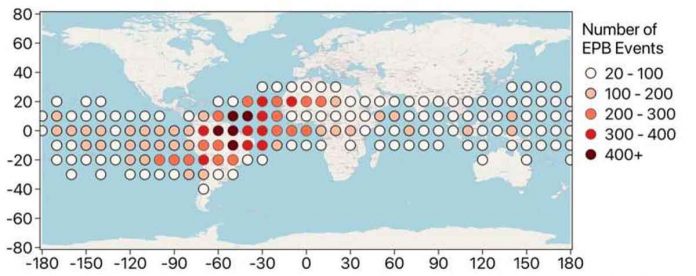After sunset, changes in atmospheric density can cause hot pockets of gas known as “plasma bubbles” to form over the Earth’s equator, causing communication disruptions between satellites and the Earth. New AI models are now assisting scientists in forecasting plasma bubble events. Sachin Reddy, a Ph.D. student at University College London, presented the work this week at the National Astronomy Meeting (NAM 2022).
Shortly after sunset, super-heated gas pockets known as “plasma bubbles” form in the upper atmosphere and stretch into space (up to 900 km above the Earth’s surface). These bubbles start small and grow quickly, expanding from the size of a football field to the size of a small country in a matter of hours. As the bubbles grow in size, they can block and warp radio signals, preventing satellites from communicating with Earth.
A team of researchers compiled 8 years of data from the SWARM satellite mission to predict plasma bubbles. The Ionospheric Bubble Index is an automatic bubble detector on board the spacecraft. This compares changes in electron density and magnetic field strength to see if there are any bubbles present: a strong correlation between the two indicates the presence of a plasma bubble.
The satellite flies through the middle of most plasma bubbles at an altitude of 460 km (about 30 times higher than a commercial plane). The model combines SWARM data with a machine learning approach to predict the likelihood of a plasma bubble event occurring at any time.

The results show that, like the weather, the number of plasma bubble events varies from season to season, and that the number of events increases with solar activity. Despite this, the model finds that location is far more important than time of year in predicting plasma bubbles, with most events occurring over a region of the Atlantic known as the South Atlantic Anomaly. Across multiple tests, the AI model predicts events with an accuracy of 91%.
According to Reddy “To avoid major disruptions to satellite services, we must be able to forecast bubbles in the same way that we forecast weather on Earth. Our goal is to be able to say things like, “At 8 p.m. tomorrow, there is a 30% chance of a bubble appearing over the Horn of Africa.” This type of data is extremely useful for spacecraft operators and people who rely on satellite data on a daily basis, such as you and me.”

